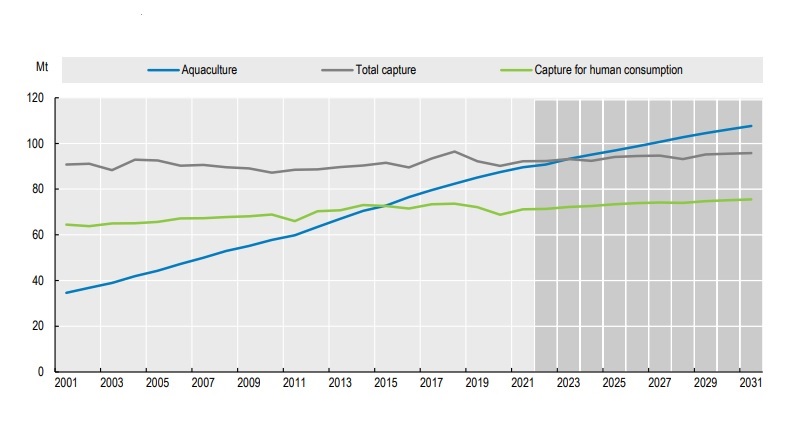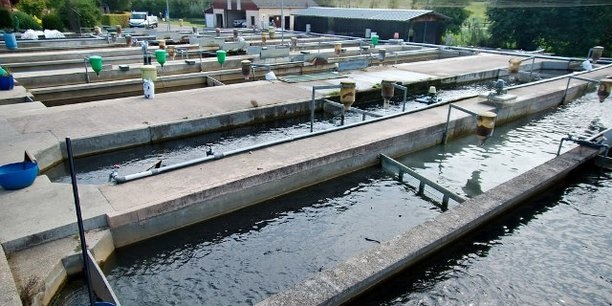CURRENT STATUS OF REGIONAL AQUACULTURE IN AFRICA, CASE OF CAMEROON
By: Dr Mustapha ABA. Aquaculture Scientific Expert. Fish Nutrition. Rabat. Morocco.
Cameroon is located at the bottom of the Gulf of Guinea in Central Africa and covers an area of 475,000 square kilometres, this geographical extension gives the country a great geographic and ecological diversity , the population in Cameroon is estimated at more than 29 million. In Cameroon, agriculture, livestock and fisheries employ more than 70% of the working population and account for 30% of GDP according to the FAO (2022). Fish accounts for 40% and 9.5% of the animal protein intake and total population requirements, respectively. There is great potential for fish production in Cameroon, as the country has significant water resources including natural inland waters covering more than 40,000 kilometres of continental land spread between artificial lakes (Lagdo, Mbakaou, Mapé, Bamendjin, Maga), the flood plains (basin of Lake Chad) and rivers within 4 major watersheds. The Government of Cameroon has recognized the important role of aquaculture and is trying to revive its aquaculture industry. The sector has become a priority for the government, which has developed a strategic framework for sustainable development of aquaculture and is revising the legal framework governing fisheries and aquaculture in Cameroon due to population growth and deterioration natural fish stocks due to overfishing, therefore, aquaculture appears to be an excellent solution for the massive demand for fish, which has led the country to develop aquaculture in order to meet the demand for fish, this aquaculture is mainly practiced in fresh water despite the 402 km of length of the Cameroonian coastline, and dominated by 2 species; the Nile tilapia and the African catfish.
Introduction
According to the OECD (2023), in order to ensure food security, world fish production should increase by 1.2% per year and should reach 203 Mt by 2031, an overall increase of 25 Mt (+14%) compared with the reference period (average 2019-2021), and by 2031, world aquaculture production should reach 108 Mt, 12 Mt more than the capture sector. Aquaculture will account for 53% of total fish supply in 2031, compared with 49% in the 2020 period (Figure 1).

Fig 1 : Aquaculture, total capture production and capture for human consumption (Source: OECD/FAO, 2022)
Fisheries catches have risen from 7 million tonnes to 10 million tonnes in 2020, while aquaculture production was around 450 000 tonnes in 2000, rising to almost 2 million 420 000 tonnes in 2020 (FAO, 2024).
The 2.4 million African aquaculture products are not evenly distributed across the continent, with African regions experiencing major disparities in aquaculture production for decades (Fig 5), with significant production since the 2000s in the North, West and East African regions, and of the 2.4 million tonnes produced in aquaculture on the African continent, North Africa produces almost 70% (almost all by Egypt), West Africa with 16.06%, while the East African region produces 15.70% of aquaculture products. Central and Southern Africa produce less than 1.3% (FAO, 2024).
Africa’s contribution to global aquaculture production is still insignificant (2%) (FAO, 2023), although it is increasing considerably with larger-scale investments in Egypt, Nigeria, Uganda and Ghana producing substantial quantities of fish (Cai et al., 2017). The region recorded a twenty-fold increase in production, rising from 1,110,200 to 2,418,844 tonnes from 1995 to 2021, with an annual growth rate of 15.55% (FAO 2023). The growth in aquaculture production shows huge disparities between the different regions of Africa, and the aim of this article is to analyse the current situation of aquaculture in the leading aquaculture producers in the 5 regions of Africa, namely Egypt in the North African region, Nigeria in the West African region, Uganda in the East African region, Cameroon in the Central African region and South Africa in the South African region.

Fig 2 : Aquaculture production in the 5 regions of Africa
CURRENT STATUS OF AQUACULTURE IN CAMEROON
Cameroon is located at the bottom of the Gulf of Guinea in Central Africa and covers an area of 475,000 square kilometres. This geographical extension gives the country great geographical and ecological diversity (FAO, 2004), and the population of Cameroon is estimated at over 29 million (Woldometer, 2024).
In Cameroon, agriculture, livestock farming and fishing employ over 70% of the working population and account for 30% of GDP (FAO, 2022). Fish accounts for 40% and 9.5% of animal protein intake and the population’s total requirements, respectively (Atangana et al., 2019). Cameroon is one of the twelve beneficiary countries of FISH4ACP, an initiative of the Organisation of African, Caribbean and Pacific States (OECP) implemented by the FAO to increase the productivity and sustainability of fisheries and aquaculture value chains in Africa, the Caribbean and the Pacific (FAO, 2022). With a coastline of over 400 kilometres, Cameroon lies on the Atlantic coast where West and Central Africa meet. As early as 1472, it was named “Rio dos Camarões”, or “river of prawns” by Portuguese explorers, due to the abundance of crustaceans discovered in the region. Today, shrimp is Cameroon’s main seafood export, with annual production estimated at 5,300 tonnes from industrial and artisanal fishing (FAO, 2022).
There is great potential for fish production in Cameroon, as the country is endowed with significant water resources, including natural inland waters covering more than 40. 000 continental kilometres divided between artificial lakes (Lagdo, Mbakaou, Mapé, Bamendjin, Maga), flood plains (Lake Chad basin) and rivers within 4 major hydrographic basins: (i) the Lake Chad basin, with its lake, main tributaries (Logone, Chari, El Beïd, Serbewel and Mayo Tsanaga) and flood plains; (ii) the Niger basin, with the Benoué, its main tributaries and the Lagdo reservoir; (iii) the Congo basin, with the Sangha and its main tributaries, the Kadei and the Ngoko; and (iv) the Atlantic basin, with numerous rivers, the main ones being the Ndian, the Moko, the Cross river, the Sanaga, the Mémé and the Nyong. These areas are the focus of major fishing activities, which contribute to employment and food security for riverside populations, as well as fish farming and biodiversity conservation, which can contribute to the external balance of trade in fishery products and satisfy national demand (Folack et al., 2000).
The Government of Cameroon has recognised the important role of aquaculture and is attempting to revive its aquaculture industry. The sector has become a priority for the government, which has drawn up a strategic framework for the sustainable development of aquaculture and is revising the legal framework governing fishing and aquaculture in Cameroon, in order to meet the strong demand from its growing population (Meliko et al. ,2021).
Fish production in Cameroon
In Cameroon, agriculture, livestock farming and fishing employ more than 70% of the working population and account for 30% of GDP. Fish accounts for 40% and 9.5% of animal protein intake and the population’s total needs, respectively (Atangana Kenfack et al., 2019).
The fishing sector plays a very important role. The total volume of catches in 2013 was estimated at 78,000 tonnes, with a contribution of 1.2% to GDP in 2009 (Pramod, 2020). Fish is the most accessible and widely consumed source of protein in Cameroon, as it is cheaper than other sources of animal protein such as bushmeat, chicken and beef (Pouomogne and Pemsl, 2008; Abolagba and Melle, 2021).
Fish catches have risen from 112,109 tonnes in 2000 to 290,330 tonnes in 2021, with an annual growth rate of 4.64%, so fish consumption has risen from 13.1 kg/year to 19.3 kg/year. Due to population growth (2.8% per year) and at the same time the deterioration of natural fish stocks due to excessive fishing, aquaculture seems to be an excellent solution to the massive demand for fish, which has led the country to develop aquaculture.
Aquaculture in Cameroon
Fish is an important source of protein, minerals, vitamins and essential unsaturated fatty acids for the most disadvantaged sections of society. Aquaculture in the form of fish farming was introduced in Cameroon in 1948 by the French colonial administration (Satia, 1991; Tangou, 2009) and has made significant progress over the past ten years (Pouomogne and Pemsl, 2008).
In 2021, Middle Africa accounted for 0.7904 per cent of Africa’s aquaculture production tonnage, with aquaculture production in Central Africa rising from 2,875 tonnes in 2000 to 19,119 tonnes in 2021 (FAO, 2023). Per capita consumption of fish and seafood in average Africa is 9.5 kg in 2019, given that aquaculture production in this region is only 19,119 tonnes, 50% of which is attributed to Cameroon with 9,800 tonnes. Despite accounting for 402 km of Cameroon’s coastline, this country has not contributed to marine aquaculture production.
Although the country has a national fisheries and aquaculture policy, a national aquaculture strategy since 2003, and an action plan since 2009 (MINEPIA, 2013), the government’s strategic objectives for aquaculture have not been achieved. The results of the aquaculture policy are not always significant. Numerous constraints persist and concern institutions, funding, site development and management techniques, with effects on production and the environment. Aquaculture development is still in its infancy in Cameroon (Atangana Kenfack et al., 2019).
Previous studies on aquaculture in Cameroon have shown good prospects for the sector at all scales of fish farming, if some of the constraints are overcome. The constraints include lack of skills, lack of technical support, lack and poor quality of fry and feed, lack of capital, lack of infrastructure, poor management and marketing (Pouomogne and Pemsl, 2008).
Fish species reared in aquaculture
In Cameroon, as in many developing countries, different cultural systems are used in fish farming. These include earthen ponds, concrete benches, concrete cages and tanks, and extensive fish farming is generally practised in ponds (Adjanke et al., 2016).
Among the highest freshwater fish species in Cameroon are; Nile tilapia with 8190 tonnes in 2023, catfish with 1540 tonnes and common carp with 25 tonnes.
Fig 1: Fish species produced in aquaculture in Cameroon in 2021 (FAO, 2023)
Nile tilapia (Oreochromis niloticus) and African catfish (Clarias gariepinus) are the two fish species mainly farmed in Cameroon, with production mainly made up of Nile tilapia at 83.6%, while catfish accounts for 15.7% (FAO, 2023).
Conclusion
Cameroon is endowed with a wealth of marine and freshwater resources that provide it with great opportunities for exploiting them in aquaculture, especially since the demand for fish is estimated at 400,000 tonnes per year. However, this sector is hampered by major difficulties encountered by fish farmers, including financial difficulties, the supply of fry and feed, and a lack of knowledge and practical skills in fish farming techniques and the management of fish farming sites.
Source : Aquaculture Feed Magazine Africa. Issue 2, Volume 1. 2024.
Source photo : https://afrique.latribune.fr/entreprises/industrie/2018-01-19/cameroun-1-6-milliard-de-fcfa-d-investissements-pour-l-agropole-de-pisciculture-de-bazou-765376.html

